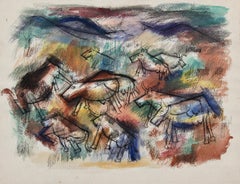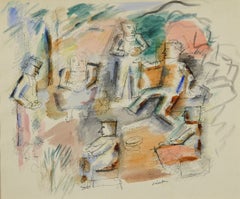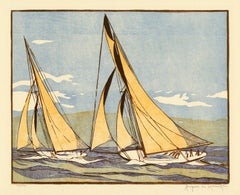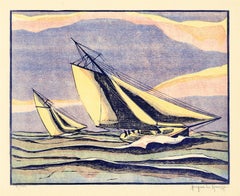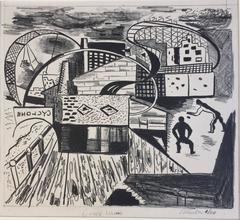Louis Schanker Art
to
8
4
4
4
1
4
2
1
Overall Height
to
Overall Width
to
3
2
6
5
5
1
1
1
1
8
5
2
1
8
6,952
3,302
2,514
1,213
4
3
2
1
1
Artist: Louis Schanker
Untitled
By Louis Schanker
Located in Lawrence, NY
Louis Schanker was an important early American modernist painter. He was best known for his work of the 30's and 40's done in a semi-abstract mode that was influenced by European m...
Category
1930s Abstract Louis Schanker Art
Materials
Oil
St. George & the Dragon
By Louis Schanker
Located in Raleigh, NC
An American modernist depiction of St. George slaying the dragon in blue. There is also another version in yellow on a black background.
Category
1940s American Modern Louis Schanker Art
Materials
Woodcut
CAFE NO. 1
By Louis Schanker
Located in Portland, ME
Schanker, Louis (American 1903-1981). CAFE NO.1. Johnson 14. Woodcut in colors, 1938. Edition of 35. Titled, numbered 8/35 and signed in pencil. 9 x 5 1/2 inches (image), plus marg...
Category
1930s Louis Schanker Art
Materials
Woodcut
FIGURE NO. 1
By Louis Schanker
Located in Portland, ME
Schanker, Louis (American 1903-1981). FIGURE NO.1. Johnson 99. Wood etching in colors, 1949. Edition of 6. Titled and signed in pencil. 25 1/2 X 13 3/8 inches (image). Framed to 33...
Category
1940s Louis Schanker Art
Materials
Woodcut
Cows in a Field (Recto) Two Figures in an Interior (Verso)
By Louis Schanker
Located in Fairlawn, OH
Cows in a Field (Recto)
Two Figures in an Interior (Verso)
Watercolor on heavy textured paper, 1938
Signed in ink verso image of Two Figures, unsigned ...
Category
1930s American Modern Louis Schanker Art
Materials
Watercolor
Interior Scene with Figures
By Louis Schanker
Located in Fairlawn, OH
Interior Scene with Figures
Ink and watercolor on paper, c. 1930's
Signed with the Estate stamp lower center
Condition: Loss upper right corner; two small tears lower margin
Colors very fresh and vibrant
Provenance: Jem Hom Gallery, Washington, D.C.
Martin Dimanond Fine Arts, NYC (?)
Louis Schanker (1903–1981)[1] was an American abstract artist.
"He grew up in an Orthodox Jewish environment in the Bronx, New York. His parents, Sam, a tailor, and Fannie Schanker, were of Romanian descent.[2] He had five siblings.[3] At an early age he had an interest in both art and music He took art courses at Cooper Union, The Educational Alliance and The Art Students League with Barnett Newman, Mark Rothko and Milton Avery amongst others. During this time he shared a coldwater studio with the Soyer brothers, Chaim Gross and Adolph Gottlieb. In 1920 he traveled across the country. He lived the hobo life, joined the Sparks and then Barnum and Bailey circuses, later working as a thresher in the wheat fields of the Great Plains. There are elements in his works such as the circus murals...
Category
1930s American Modern Louis Schanker Art
Materials
Watercolor
GIRL WITH LUTE
By Louis Schanker
Located in Portland, ME
Schanker, Louis (American 1903-1981). GIRL WITH LUTE. Johnson 18. Linocut in colors, 1938. Edition of 10. Titled, numbered 6/10 and signed in pencil. 5 1/2 x...
Category
1930s Louis Schanker Art
Materials
Linocut
CIRCLE IMAGE NO. 25
By Louis Schanker
Located in Portland, ME
Schanker, Louis. CIRCLE IMAGE NO. 25. Relief Print in color, 1954-1955. Edition of 210 published by IGAS. Signed and numbered 17/200 (the edition included 10 artist's proofs). 14 x 1...
Category
1950s Abstract Louis Schanker Art
Materials
Woodcut
Related Items
'The Start of the Race' — America's Cup, 1899
By Jacques La Grange
Located in Myrtle Beach, SC
Jacques La Grange, 'The Start of the Race, 1899', color woodcut, edition 500, 1934. Signed and numbered '21/500' in pencil. A fine impression, with fresh colors, on cream wove paper,...
Category
1930s American Modern Louis Schanker Art
Materials
Woodcut
'Racing in a Storm' — America's Cup, 1885
By Jacques La Grange
Located in Myrtle Beach, SC
Jacques La Grange, 'Racing in a Storm, 1885', color woodcut, edition 500, 1934. Signed and numbered '21/500' in pencil. A fine impression, with fresh colors, on cream wove paper, wit...
Category
1930s American Modern Louis Schanker Art
Materials
Woodcut
'The Yankee' — America's Cup, 1934
By Jacques La Grange
Located in Myrtle Beach, SC
Jacques La Grange, 'The Yankee', color woodcut, edition 500, 1934. Signed and numbered '25/500' in pencil. A fine impression, with fresh colors, on cream wove paper, with margins (1 1/8 to 1 1/4 inches), in excellent condition. A work from La Grange’s celebrated series of woodcuts 'Drama and Color in the America's Cup Races'. Image size 10 x 10 11/16 inches (254 x 271 mm); sheet size 12 1/4 x 13 1/4 inches (311 x 337 mm). Archivally matted to museum standards, unframed.
When the artist created this print in 1934, the 'Yankee' was one of the most promising yachts eligible for the America's Cup but ultimately 'Rainbow' was chosen to defend against England's 'Endeavor' in that year's race. The 'Endeavor' was built for Thomas Sopwith who used his aviation design expertise to ensure the yacht was the most advanced of its day with a steel hull and mast. She was launched in 1934 and won many races in her first season but the Cup challenge was blighted by a strike of Sopwith's professional crew prior to departing for America. Forced to rely mainly on keen amateurs, who lacked the necessary experience, the campaign failed. 'Rainbow' won the series 4–2. This was one of the most contentious of the America's Cup battles and prompted the headline "Britannia rules the waves and America waives the rules."
ABOUT THE ARTIST
Jacques La Grange was born in Clanwilliam (near Cape Town) in South Africa in 1895. He studied at London University and later immigrated to the United States. La Grange established himself as a painter, illustrator, and printmaker specializing in nautical subjects. He and his wife, Helen La Grange, published 'Drama and Color in the America's Cup Races' in 1934 and 'Clipper Ships of America and Great Britain 1833-1869', in 1936. Both were deluxe hardcover limited edition volumes with signed original color woodblock prints. La Grange had solo exhibitions at the Buchanan Gallery in 1929; the Babcock Gallery and the 56th Street Gallery, New York, in 1930; and at the Nicholas Roerich...
Category
1930s American Modern Louis Schanker Art
Materials
Woodcut
'After the Start' — America's Cup, 1893
By Jacques La Grange
Located in Myrtle Beach, SC
Jacques La Grange, 'After the Start', color woodcut, edition 500, 1934. Signed and numbered '25/500' in pencil. A fine impression, with fresh colors, on cream wove paper, with margins (1 1/4 to 1 5/8 inches), in excellent condition. Archivally matted to museum standards, unframed.
A work from La Grange’s celebrated series of woodcuts 'Drama and Color in the America's Cup Races'.
Image size 9 5/8 x 12 1/8 inches (244 x 384 mm); sheet size 12 1/4 x 15 1/8 inches (311 x 384 mm).
ABOUT THE ARTIST
Jacques La Grange was born in Clanwilliam (near Cape Town) in South Africa in 1895. He studied at London University and later immigrated to the United States. La Grange established himself as a painter, illustrator, and printmaker specializing in nautical subjects. He and his wife, Helen La Grange, published 'Drama and Color in the America's Cup Races' in 1934 and 'Clipper Ships of America and Great Britain 1833-1869', in 1936. Both were deluxe hardcover limited edition volumes with signed original color woodblock prints. La Grange had solo exhibitions at the Buchanan Gallery in 1929, the Babcock Gallery and the 56th Street Gallery in New York in 1930, and at the Nicholas Roerich...
Category
1930s American Modern Louis Schanker Art
Materials
Woodcut
'The Magic Is Ahead' — America's Cup, 1870
By Jacques La Grange
Located in Myrtle Beach, SC
Jacques La Grange, 'The Magic Is Ahead, 1870', color woodcut, edition 500, 1934. Signed and numbered '21/500' in pencil. A fine impression, with fresh colors, on cream wove paper, wi...
Category
1930s American Modern Louis Schanker Art
Materials
Woodcut
Seated Rainbow Nude Figure
By M. E. 'Mike' Bailey
Located in Soquel, CA
Rich rainbow of saturated color in this study of a nude figure by listed California artist M. E. "Mike" Bailey (American, 1943). Signed by the artist, lower right. Presented in a fro...
Category
Early 2000s American Modern Louis Schanker Art
Materials
Watercolor, Archival Paper
'Sea And Sky' — 1930s Modernism
By Rockwell Kent
Located in Myrtle Beach, SC
A brilliant, black impression, on cream wove Japan; the full sheet with margins (2 to 2 1/2 inches), in excellent condition. Edition 150. Signed in pencil. Matted to museum standards...
Category
1930s American Modern Louis Schanker Art
Materials
Woodcut
Dusk
By Louisa Chase
Located in New York, NY
Louisa Chase was born in Panama City, Panama. Seven years later, her family moved to Lancaster, Pennsylvania. She studied painting and sculpture at Syracuse University and at the Yal...
Category
Late 20th Century American Modern Louis Schanker Art
Materials
Woodcut
Underwater — Mid-century Modern
By Charles Quest
Located in Myrtle Beach, SC
Charles Quest, 'Underwater', 1948, chiaroscuro wood engraving, edition 12. Signed, titled, dated and numbered '3/12' in pencil. A fine, richly-inked impression, in dark brown and warm black, on off-white wove paper, with full margins (5/8 to 1 1/2 inch), in excellent condition. Scarce.
ABOUT THE ARTIST
Charles Quest, painter, printmaker, and fine art instructor, worked in various mediums, including mosaic, stained glass, mural painting, and sculpture. Quest grew up in St. Louis, his talent evident as a teenager when he began copying the works of masters such as Michelangelo on his bedroom walls. He studied at the Washington University School of Fine Arts, where he later taught from 1944 to 1971. He traveled to Europe after his graduation in 1929 and studied at La Grande Chaumière and Academie Colarossi, Paris, continuing to draw inspiration from the works of the Old Masters.
After returning to St. Louis, Quest received several commissions to paint murals in public buildings, schools, and churches, including one from Joseph Cardinal Ritter, to paint a replica of Velasquez's Crucifixion over the main altar of the Old Cathedral in St. Louis. Quest soon became interested in the woodcut medium, which he learned through his study of J. J. Lankes' A Woodcut Manual (1932) and Paul Landacre's articles in American Artist magazine ‘since no artists in St. Louis were working in wood’ at that time. Quest also revealed that for him, wood cutting and engraving were ‘more enjoyable than any other means of expression.’
In the late 1940s, his graphic works began attracting critical attention—several of his woodcuts won prizes and were acquired by major American and European museums. His wood engraving entitled ‘Lovers’ was included in the American Federation of Art's traveling print exhibition in 1947. Two years later, Quest's two prize-winning prints, ‘Still Life with Grindstone’ and ‘Break Forth into Singing’, were exhibited in major American museums in a traveling show organized by the Philadelphia Print Club. His work was included in the Chicago Art Institute's exhibition, ‘Woodcut Through Six Centuries’, and the print ‘Still Life with Vise’ was purchased by the Museum of Modern Art in New York.
In 1951 he was invited by artist-Curator Jacob Kainen to exhibit thirty wood engravings and color woodcuts in a one-person show at the Smithsonian's National Museum (now known as the American History Museum). Kainen's press release praised the ‘technical refinement’ of Quest's work: ‘He obtains a great variety of textural effects through the use of the graver, and these dense or transparent grays are set off against whites or blacks to achieve sparkling results. His work has the handsome qualities characteristic of the craftsman and designer.’
At the time of the Smithsonian exhibition, Quest's work was represented by three New York galleries in addition to one in his home town. He had won 38 prizes, and his prints were in the collections of the Library of Congress, the Chicago Art Institute, the Metropolitan Museum, and the Philadelphia Museum of Art. In cooperation with the Art in Embassies program, his color woodcuts were displayed at the American Embassy in Paris in 1951.
Recognition at home came in 1955 with his first solo exhibition in St. Louis. Press coverage of the show heralded the ‘growth of graphic arts toward rivaling painting and sculpture as a major independent medium’.
An exhibition of his prints at the Bethesda Art Gallery in 1983 attracted Curator Emeritus Joseph A. Haller, S.J., who began purchasing his work for Georgetown University's collection. In 1990 Georgetown University Library's Special Collections Division was the recipient of a large body of Quest's work, including prints, drawings, paintings, sculpture, stained glass, and his archive of correspondence and professional memorabilia. These extensive holdings, including some 260 of his fine prints, provide a rich opportunity for further study and appreciation of this versatile and not-to-be-forgotten mid-Western American artist...
Category
1940s American Modern Louis Schanker Art
Materials
Woodcut
Fountain of Sea Horses, Rome — Early 20th Century
By Rudolph Ruzicka
Located in Myrtle Beach, SC
Rudolph Ruzicka, 'Fountain of Sea Horses, Rome', wood engraving, c. 1915. Signed, dated, and titled in pencil. Initialed in the block, lower left. A fine, richly-inked impression, on...
Category
1910s American Modern Louis Schanker Art
Materials
Woodcut
Rare Chaim Gross Watercolor Painting Manhattan Skyscrapers Train NYC WPA Artist
By Chaim Gross
Located in Surfside, FL
This appears to be dated 1927. It came in with a piece dated 1929. A very early, rare work.
Framed 22.5 x 18. Image 14.5 x 9
A great New York city street scene with an El train (elevated subway line) and architectural renderings of buildings.
This is a wonderful piece by one of America's most treasured artists, Chaim Gross. Throughout his lifetime Gross has gone through tragedy and a real test of faith however, he has the unique ability to focus and direct his expression to the most joyful and beautiful works of art, such as the present lot. For more than sixty years Chaim Gross's art has expressed optimistic, affirming themes. His acrobats, cyclists, and mothers and children convey joyfulness, exuberance, love, and intimacy. This aspect of his work
remained consistent with his Hasidic heritage, which teaches that "only in his childlike happiness is man nearest to God." He often used his creative abilities to explore and experiment with media. In his artwork he retains an optimistic philosophy, even when facing somber issues such as war, depression, and the Holocaust.
Chaim Gross (March 17, 1904 – May 5, 1991) was an American sculptor and educator.
Gross was born to a Jewish family in Austrian Galicia, in the village of Wolowa (now known as Mezhgorye, Ukraine), in the Carpathian Mountains. In 1911, his family moved to Kolomyia (which was annexed into the Ukrainian USSR in 1939 and became part of newly independent Ukraine in 1991). When World War I ended, Gross and brother Avrom-Leib went to Budapest to join their older siblings Sarah and Pinkas. Gross applied to and was accepted by the art academy in Budapest and studied under the painter Béla Uitz, though within a year a new regime under Miklos Horthy took over and attempted to expel all Jews and foreigners from the country. After being deported from Hungary, Gross began art studies at the Kunstgewerbeschule in Vienna, Austria shortly before immigrating to the United States in 1921. Gross's studies continued in the United States at the Beaux-Arts Institute of Design, where he studied with Elie Nadelman and others, and at the Art Students League of New York, with Robert Laurent. He also attended the Educational Alliance Art School, studying under Abbo Ostrowsky, at the same time as Moses Soyer and Peter Blume.
In 1926 Gross began teaching at The Educational Alliance, and continued teaching there for the next 50 years. Louise Nevelson was among his students at the Alliance (in 1934), during the time she was transitioning from painting to sculpture. In the late 1920s and early 1930s he exhibited at the Salons of America exhibitions at the Anderson Galleries and, beginning in 1928, at the Whitney Studio Club. In 1929, Gross experimented with printmaking, and created an important group of 15 linocuts and lithographs of landscapes, New York City streets and parks, women in interiors, the circus, and vaudeville. The entire suite is now in the collection of the Philadelphia Museum of Art. Gross returned to the medium of printmaking in the 1960s, and produced approximately 200 works in the medium over the next two decades.
In March 1932 Gross had his first solo exhibition at Gallery 144 in New York City. For a short time they represented Gross, as well as his friends Milton Avery, Moses Soyer, Ahron Ben-Shmuel and others.
Gross was primarily a practitioner of the direct carving method, with the majority of his work being carved from wood. Other direct carvers in early 20th-century American art include William Zorach, Jose de Creeft, and Robert Laurent. Works by Chaim Gross can be found in major museums and private collections throughout the United States, with substantial holdings (27 sculptures) at the Hirshhorn Museum and Sculpture Garden. A key work from this era, now at the Smithsonian American Art Museum, is the 1932 birds-eye maple Acrobatic Performers, which is also only one and one quarter inch thick.
In 1933 Gross joined the government's PWAP (Public Works of Art Project), which transitioned into the WPA (Works Progress Administration), which Gross worked for later in the 1930s. Under these programs Gross taught and demonstrated art, made sculptures that were placed in schools and public colleges, made work for Federal buildings including the Federal Trade Commission Building, and for the France Overseas and Finnish Buildings at the 1939 New York World's Fair. Gross was also recognized during these years with a silver medal at the Exposition universelle de 1937 in Paris, and in 1942, with a purchase prize at the Metropolitan Museum of Art's "Artists for Victory" exhibition for his wood sculpture of famed circus performer Lillian Leitzel.
In 1949 Gross sketched Chaim Weizmann, President of Israel, at several functions in New York City where Weizmann was speaking, Gross completed the bust in bronze later that year. Gross returned to Israel for three months in 1951 (the second of many trips there in the postwar years) to paint a series of 40 watercolors of life in various cities. This series was exhibited at the Jewish Museum (Manhattan) in 1953.
In the 1950s Gross began to make more bronze sculptures alongside his wood and stone pieces, and in 1957 and 1959 he traveled to Rome to work with famed bronze foundries including the Nicci foundry. At the end of the decade Gross was working primarily in bronze which allowed him to create open forms, large-scale works and of course, multiple casts. Gross's large-scale bronze The Family, donated to New York City in 1991 in honor of Mayor Ed Koch, and installed at the Bleecker Street Park at 11th street, is now a fixture of Greenwich Village. In 1959, a survey of Gross's sculpture in wood, stone, and bronze was featured in the exhibit Four American Expressionists curated by Lloyd Goodrich at the Whitney Museum of American Art, with work by Abraham Rattner, Doris Caesar, and Karl Knaths. In 1976, a selection from Gross's important collection of historic African sculpture, formed since the late 1930s, was exhibited at the Worcester Art Museum in the show The Sculptor's Eye: The African Art Collection of Mr. and Mrs. Chaim Gross. Gross was elected into the National Academy of Design as an Associate member, and became a full Academician in 1981. In 1984, he was inducted into the American Academy of Arts and Letters, with Jacob Lawrence and Lukas Foss. In the fall of 1991, Allen Ginsberg gave an important tribute to Gross at the American Academy of Arts and Letters, which is published in their Proceedings. In 1994, Forum Gallery, which now represents the Chaim Gross estate, held a memorial exhibition featuring a sixty-year survey of Gross's work.
Gross was a professor of printmaking and sculpture at both the Educational Alliance and the New School for Social Research in New York City, as well as at the Brooklyn Museum Art School, the MoMA art school, the Art Student's League and the New Art School (which Gross ran briefly with Alexander Dobkin...
Category
Mid-20th Century American Modern Louis Schanker Art
Materials
Paper, Watercolor
'The Bather' — 1930s American Modernism
By Rockwell Kent
Located in Myrtle Beach, SC
Rockwell Kent, 'The Bather', wood engraving, 1931, edition 120, Burne Jones 63. Signed in pencil. A brilliant, black impression, on cream, wove Japan paper; the full sheet with margins (2 1/2 to 3 1/4 inches); slight skinning at the top sheet edge, verso, otherwise in excellent condition. Image size 5 3/8 x 7 7/8 inches (137 x 200 mm); sheet size 11 1/8 x 14 1/2 inches (283 x 368 mm). Archivally matted to museum standards, unframed.
Impressions of this work are held in the following public collections: Burne Jones Collection, IL; Chegodaev Collection, Moscow; Kent Collection, NY; Philadelphia Museum of Art; Princeton University Library, NJ; Pushkin Museum, Moscow; Smithsonian American Art Museum, Spector Collection, NY.
Rockwell Kent (1882-1971), though best known as a painter, graphic artist, and illustrator, pursued many careers throughout his life, including architect, carpenter, explorer, writer, dairy farmer, and political activist. Born in Tarrytown, New York, Kent was interested in art from a young age. These ambitions were encouraged by his aunt Jo Holgate, an accomplished ceramicist. Jo came to live with the family after Kent’s father passed away in 1887 and took him to Europe as a teenager, undoubtedly kindling his interest in exploring the world.
Kent attended the Horace Mann School in New York City, where he excelled at mechanical drawing. His family’s financial circumstances prevented him from pursuing a career in the fine arts; however, after graduating from Horace Mann in 1900, Kent decided to study architecture at Columbia University.
Before matriculating at Columbia, Kent spent the first of three consecutive summers studying painting at William Merritt Chase’s art school in Shinnecock Hills, Long Island. There he found a community of mentors and fellow students who encouraged him to pursue his interest in art. At the end of Kent’s third summer at Shinnecock, Chase offered him a full scholarship to the New York School of Art, where he was a teacher. Kent began taking night classes at the art school in addition to his architecture studies but soon left Columbia to study painting full-time. In addition to Chase, Kent took classes with Robert Henri and Kenneth Hayes Miller, where his classmates included the artists George Bellows and Edward Hopper.
Kent spent the summer of 1903 assisting the eccentric painter Abbott Handerson Thayer at his studio in Dublin, New Hampshire—a position he secured through the recommendation of his Aunt Jo. Thayer’s naturalist lifestyle and almost mystical appreciation for natural phenomena greatly influenced Kent; he returned to Dublin for many years to visit Thayer and his family. Thayer gave the young artist time to pursue his work, and that summer Kent painted several views of the New Hampshire landscape, including Mount Monadnock...
Category
1930s American Modern Louis Schanker Art
Materials
Woodcut
Previously Available Items
CYCLONE, CONEY ISLAND ca 1933
By Louis Schanker
Located in Santa Monica, CA
LOUIS SCHANKER (1903 – 1981)
CYCLONE, CONEY ISLAND ca 1933
Lithograph 10 7/8 x 12 ½” signed, and with no. 1/10. Rare thus!
Annotation: Coney Island. ...
Category
1930s American Modern Louis Schanker Art
Materials
Lithograph
Louis Schanker art for sale on 1stDibs.
Find a wide variety of authentic Louis Schanker art available for sale on 1stDibs. You can also browse by medium to find art by Louis Schanker in woodcut print, paint, watercolor and more. Much of the original work by this artist or collective was created during the 20th century and is mostly associated with the modern style. Not every interior allows for large Louis Schanker art, so small editions measuring 12 inches across are available. Customers who are interested in this artist might also find the work of Warrington Colescott, Fred Nagler, and Howard Norton Cook. Louis Schanker art prices can differ depending upon medium, time period and other attributes. On 1stDibs, the price for these items starts at $750 and tops out at $10,500, while the average work can sell for $1,500.



